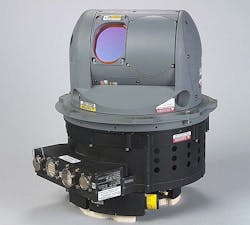Northrop Grumman gets ready to install two-color electro-optical sensors P-8A missile-defense system
Officials of the U.S. Naval Air Systems Command at Patuxent River Naval Air Station, Md., awarded a $7 million delivery order to the Northrop Grumman Electronic Systems segment in Rolling Meadows, Ill., to start installing two-color infrared sensors in the P-8's AN/AAQ-24 Directional Infrared Countermeasures (DIRCM) system.
The order calls for engineers from the Northrop Grumman Electronic Systems Land and Self Protection Systems Division to provide supplies and services to develop software to upgrade the current P-8A AN/AAQ-24 DIRCM electro-optical subsystem with two-color infrared missile warning sensors.
Using two-color sensors in the DIRCM missile-defense system is intended to improve's the system's effectiveness against modern shoulder-fired anti-aircraft missiles that have low-intensity and difficult-to-detect plumes.
Related: Boeing to update P-8A electronic warfare components to stave-off obsolescence
The Northrop Grumman DIRCM laser-based system is designed to protect aircraft from infrared guided missiles. The system detects one or more incoming enemy missiles by their exhaust trails and blinds the missile guidance sections with precision-aimed lasers.
The company's DIRCM system simultaneously tracks and defeats incoming missiles in clutter environments; provides fast threat detection and simultaneous jamming in all current IR threat bands; counters fielded IR missiles using a generic jam waveform; and offers end-to-end self-testing.
The Navy's Boeing P-8A is a variation of the Boeing 737-800 single-aisle passenger jetliner modified for maritime patrol and anti-submarine warfare (ASW). Ultimately, the Navy plans to buy 108 P-8A aircraft from Boeing to replace the service’s fleet of 196 P-3C Orion maritime patrol aircraft, which are approaching the end of operational life. The P-3 is a version of the Lockheed Martin Electra four-engine turboprop aircraft.
Aircraft missile warning systems typically operate in the ultraviolet wavelength to detect the plumes of incoming infrared, or heat-seeking missiles. Ultraviolet sensors, however, are best a detecting relatively old missiles with bright exhaust flames. Infrared sensors, on the other hand, can have difficulty in high-clutter backgrounds.
Using two separate electro-optical sensors in the same system helps measure the contrast between missile plume and background to extend the system's detection range against incoming missiles with a wide range of missile propellants and help lengthen reaction times.
On this order Northrop Grumman will do the work in Rolling Meadows, Ill.; Jacksonville, Fla.; and Valparaiso, Fla., and should be finished by October.
For more information contact Northrop Grumman Electronic Systems online at www.northropgrumman.com, or Naval Air Systems Command at www.navair.navy.mil.
